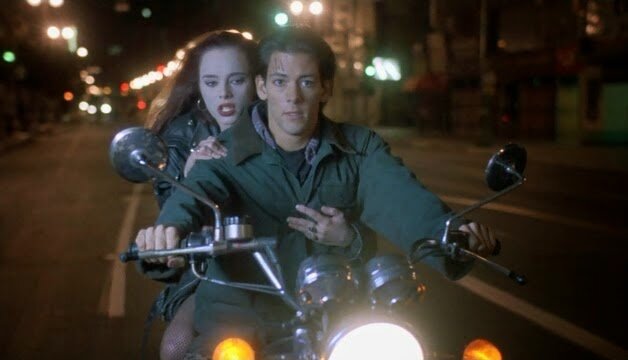For years, I’d avoided 1993’s Return of the Living Dead III. There was something about the cover art that screamed cash in, low effort sequel to me. Books and covers, I know. I should’ve known better, too, considering I really like the theatrical poster for II but find the actual movie to be merely okay. Anyways, flash forward and the film seems to be getting a bit of a reappraisal from horror fans in recent times. It was then brought to my attention that Brian Yuzna, producer on Re-Animator (1985) and director of Society (1989), directed the piece. Well, now I had to see it.
At a Los Angeles area military base, Colonel John Reynolds (Kent McCord) unveils the results of his long gestating project to use Trioxin gas infused zombies as unkillable combatants. Colonel Peck (James T Callahan) is initially impressed, but Colonel Sinclair (Sarah Douglas) is less enthused as her idea of placing zombies in exoskeletons was passed over in favor of Reynolds’ method of chemically freezing the ghouls’ brains as a means of control. Unbeknownst to the officers, the demonstration is also viewed by Reynolds’ rebellious son Curt (J Trevor Edmond) and his thrill seeking girlfriend Julie (Melinda “Mindy” Clarke). Of course, something goes awry, leading to a chain of events that ends with Julie’s death. Unable to accept this tragedy, Curt reanimates Julie using the Trioxin. The star-crossed lovers are then forced to go on the run as the zombie infection creeps out into the city and as Julie attempts to stave off her unnatural cravings for brains by cutting and piercing her own slowly decaying flesh. There are also subplots involving a mentally ill vagrant named Riverman (Basil Wallace) and a group of angry street toughs.
John Penney’s scripting is much tighter than I expected. Cause and effect structuring lends the film propulsion and purpose. Characters are broadly drawn but distinctive. All the performers are game, too, with Clarke standing out as an undead masochist struggling to accept her bizarre circumstances. I also appreciated Wallace’s kooky performance. There are oblique in-story references to previous franchise entries as well as George Romero’s original Night of the Living Dead, but the most obvious allusions are more meta. For example, Julie is a ‘90s reworking of Linnea Quigley’s Trash from the original film, but placed front and center, and the street toughs are reminiscent of Trash’s punker cohorts. I don’t know that I found the love story that anchors the film to be all that compelling, but it certainly presents a unique flavor.
The main element of the flick that stood out to me was how it fairly screams ‘90s youth culture. I was a teenager when this film was produced and the costumes are definitely authentic. Curt and Julie’s mopey attitudes ring true and Barry Goldberg’s score seems indebted to acts like Mazzy Star and The Jesus and Mary Chain. Though the score is nicely done, it’s a little disappointing that there isn’t any soundtrack to speak of, considering that’s a vital element of what makes the original film so memorable. A coterie of ‘90s era alt-rock layered over the visuals would’ve brought the film to another level.
Gore effects, makeup, and creature design are all pleasingly executed. In particular, the ghouls that escape from the military’s sealed barrels are gooey, grotesque, and nicely detailed. Also, toward the end of the film, the exoskeleton sequence is imaginative and cool. Gerry Lively’s lensing, while not flashy, brings competent immersion in the story. Sets like Curt’s bedroom and Riverman’s hovel, and locations like the dank Los Angeles River aqueduct, compliment the actors’ performances. My favorite set, though, is the maze-like, cold, minimalist, and windowless corridors of the military base. Despite a relatively low budget (purportedly $2M), Yuzna and his team squeeze out a ton of production value.
Look, Brian Yuzna’s Return of the Living Dead III isn’t a genre classic like Dan O’Bannon’s franchise originator, but it’s still pretty fun. It’s much better than II, for sure. Replacing the comedic approach with angsty romance certainly gives this installment a quirky identity that helps set it apart. It may come across as dated to some viewers, but I actually enjoy that it’s a bit of a ‘90s time capsule. Recommended for fans of depressed teenagers, morally ambiguous mad scientists, and slimy practical makeup effects.
Michael Cavender




